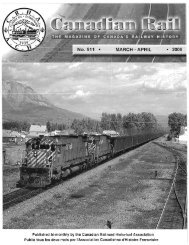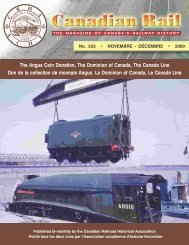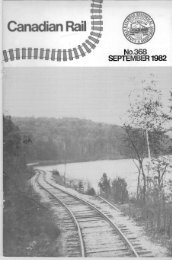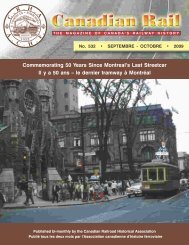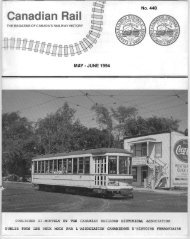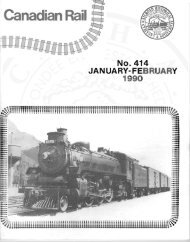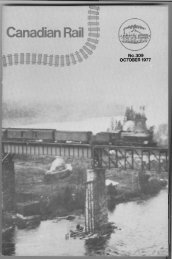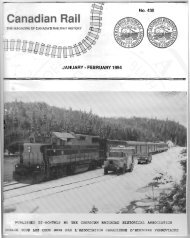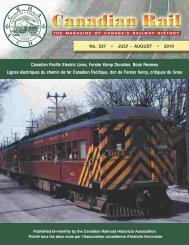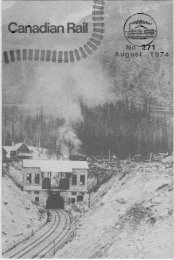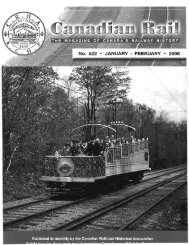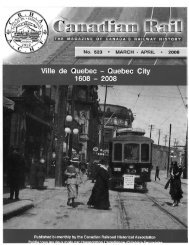Canadian Rail_no539_2010 - Le musée ferroviaire canadien
Canadian Rail_no539_2010 - Le musée ferroviaire canadien
Canadian Rail_no539_2010 - Le musée ferroviaire canadien
Create successful ePaper yourself
Turn your PDF publications into a flip-book with our unique Google optimized e-Paper software.
NOVEMBER – DECEMBER <strong>2010</strong><br />
273 CANADIAN RAIL • 539<br />
Continued from page 263<br />
Steam at night<br />
Riding in the dimly lit cab of a steam locomotive<br />
at night was always thrilling for me. The feel of the<br />
powerful pistons as they rocked the engine from side to<br />
side, the smell of the coal smoke, the illuminated pressure<br />
gauges and the water glass indicating the water level in the<br />
boiler, created an atmosphere that can never be<br />
duplicated. The engine was alive: a big heavy monster<br />
responding to the commands of the engineer at the<br />
throttle. We picked up speed rapidly as the track dipped<br />
down toward the Assiniboine River. In a moment or two<br />
the big overhead span of the bridge loomed out of the<br />
darkness in front us, illuminated by our headlight. As we<br />
shot across, there was a sudden change in the sound as the<br />
reflected noise level changed each time we passed a girder<br />
on the bridge. We had a good swing on our train heading<br />
over from Brandon to Shilo and as the train order board<br />
appeared in the distance in front of us Alistair shouted,<br />
"Clear board."<br />
The ‘California’ style cab<br />
We got called for a trip to Brandon at<br />
22:15K on October 16, 1956 with engine 3335<br />
and didn’t arrive at our destination until shortly<br />
after noontime the following day, being on duty<br />
slightly over fifteen hours. With less than four<br />
hours sleep, we were called again for 18:30 to<br />
return to Winnipeg with engine 2503. This was<br />
an old brute of an engine with a 2-8-0-wheel<br />
configuration and a California style cab. It was<br />
referred to as a ‘California’ style cab because<br />
there were no doors on the cab of the engine<br />
where the crew rode, only heavy canvas curtains.<br />
These curtains were pulled across the door<br />
openings on each side and tied shut with a piece<br />
of string or wire to keep them from blowing<br />
open in the cold night air. As far as the head-end<br />
brakeman was concerned, it was a real pig of an<br />
engine because, just like the old 1300 and 2100<br />
class engines, the brakeman had to ride jammed<br />
into a little seat beside the boiler and ahead of<br />
the fireman. To get into this seat, you had to fold<br />
the back of it down and then climb over. The<br />
side window would not slide forward far enough<br />
to make it easy for the brakeman to get his head<br />
out for an unobstructed view ahead when on a<br />
left-hand curve. He had to stand on his toes and<br />
push back to get his shoulders far enough back<br />
to get his head out of the window. Alistair<br />
McGregor was the engineer this evening and<br />
eighteen-year-old Robert Kellock was our<br />
fireman. Robert had only hired out on the<br />
railroad three weeks earlier.<br />
Checking the water in the tender<br />
The fireman and the brakeman often helped<br />
each other out in their respective jobs. Sometimes the<br />
fireman would get a switch for the brakeman or the<br />
brakeman would shovel coal for the fireman. It made for<br />
good friendly relations and a sense of comradeship.<br />
On one particular cold winter night we were<br />
heading for Dauphin. As we were approaching<br />
McCreary, the fireman was having some trouble and was<br />
quite busy with his fire. The engineman was hoping to run<br />
the tank and go right to Dauphin, but was afraid to do so<br />
without knowing for sure exactly how much water he had<br />
left in the tender. He looked over to me and asked if I<br />
would mind checking the level. I wasn’t at all enamoured<br />
with the thoughts of climbing out onto the swaying tender<br />
in the dark through the smoke and the steam to see how<br />
much water we had left. But, I figured that if the fireman<br />
had enough guts to climb out there under those<br />
conditions, then so did I. So, out I went with my electric<br />
lantern slung over my arm.<br />
Oiling was a big part of keeping the steamers rolling. Here a fireman is<br />
oiling CPR Selkirk 5935 circa 1950. This locomotive forms part of the<br />
CPR historic collection at Exporail.<br />
La lubrification était une tâche importante pour maintenir le bon<br />
fonctionnement d’une locomotive à vapeur. Ici, un chauffeur lubrifie la<br />
Selkirk no 5935 du CPR dans les années 1950. Cette locomotive fait<br />
partie de la collection historique du CPR à Exporail.



